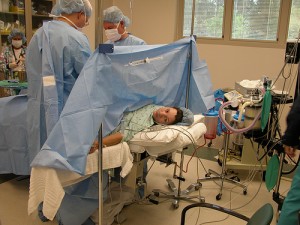
There is no doubt that caesarean sections (c-sections) save mothers’ and babies’ lives, but the World Health Organization (WHO) has long declared this surgical procedure overused in many countries throughout the world. As we’ve reported before, the US c-section rate is 31.8%, half of those being elective procedures, and that rate continues to rise. WHO recommends “optimal cesarean section rates” to be between five and ten percent, with greater risks for women in countries whose percentages rise above 15.
Whether medically necessary or not, the latest information from WHO is that all caesareans “put women at increased risk of adverse events, including death”.
Why are more and more mothers in the US delivering their babies via c-sections given the risks or morbidity and mortality? Childbirth Connection offers the following reasons:
- Low priority of enhancing women’s own abilities to give birth
- Side effects of common labor interventions
- Refusal to offer the informed choice of vaginal birth
- Casual attitudes about surgery and cesarean sections in particular
- Limited awareness of harms that are more likely with cesarean section
- Providers’ fears of malpractice claims and lawsuits
- Incentives to practice in a manner that is efficient for providers
Published in the Lancet, the latest phase of the WHO’s Global Survey on Maternal and Perinatal Health Research Group reviewed births in nine Asian countries. China had the highest overall c-section rate of 46.2%, including 11.7% “without indication”. Medscape reports:
Any operative procedure increased the maternal mortality and morbidity index (defined as blood transfusion, hysterectomy, internal iliac artery ligation, or death or ICU admission) to a greater extent than spontaneous delivery…
Dr. Lumbiganon and associates maintain that “the most important finding of the survey is the increased risk of maternal mortality and severe morbidity…in women who undergo caesarean section with no indication.” The increased risk is primarily due to higher rates of ICU admission and blood transfusion.
“If this operation is limited to medical indications and unnecessary use is avoided, resources will be used for a need and will not be taken from other parts of the health system,” the authors write.
I am sure that you know at least one person that has delivered their baby via c-section. Some of these babies and mothers truly required the operation, but statistically, some of them did not. As the WHO study’s authors interpret, “To improve maternal and perinatal outcomes, caesarean section should be done only when there is a medical indication.“
The conclusion in this report by the WHO is flawed, and media reports in the last few days demonstrate that journalists are not reading the full study for themselves. Instead, they are relying on the distorted summary provided by the WHO researchers.
If you read the study and look at its tables of data (before the WHO researchers reorganize the data into a special ‘index’ of results that supports a vaginal delivery bias), it is clear that planned cesarean without medical indication is NOT less safe than a planned vaginal delivery.
This study should not be used to criticize women for making a perfectly legitimate birth plan decision.
I have written a commentary on the study here:
http://cesareandebate.blogspot.com/2010/01/study-advises-against-non-medial.html
Though I agree c-sections are over used in America and that society puts the fear of vaginal birth into women I think that they have their place. Even for voluntary purposes. For instance if I had every had a 3rd child I would more then likely opt for a planned c-section because of my history of tramautic labors (the 2nd one ended in c-section). Seeing as I am not willing to put myself through that experience a 3rd time I would voluntarily opt for a c-section. All surgeries carry risks whether it be an appendectomy, coronary bypass, or c-section that is not new news.